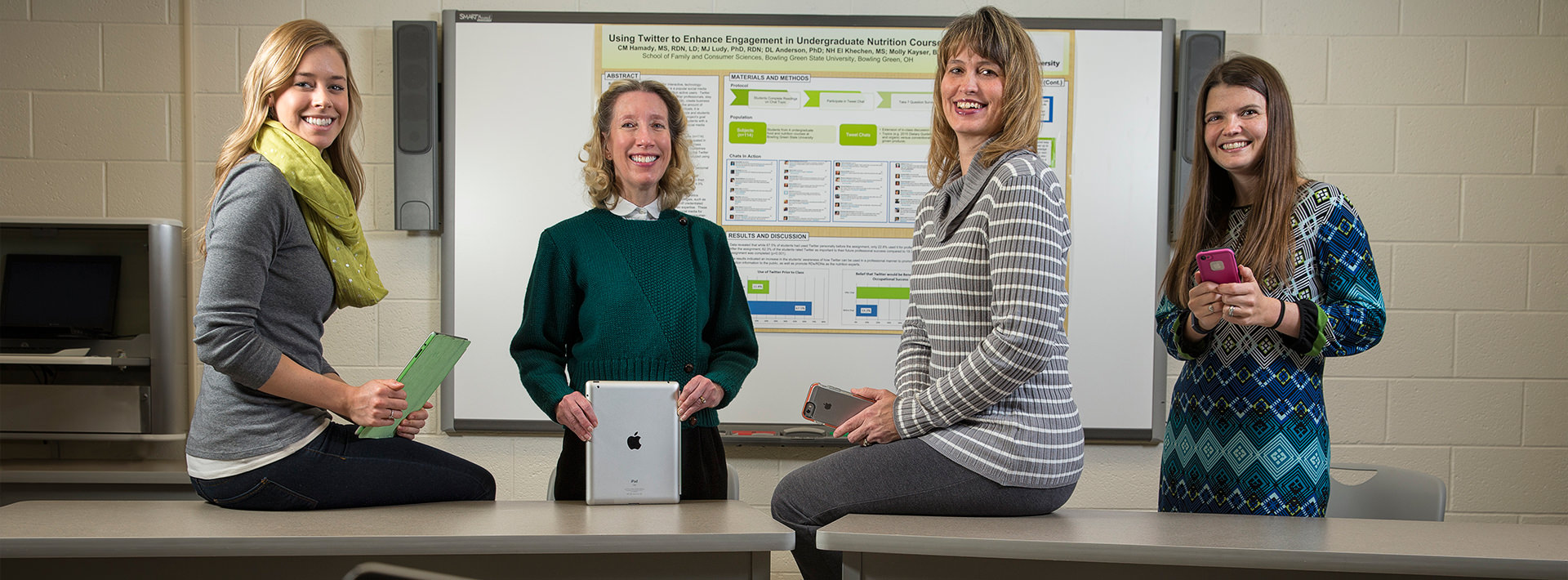Dietetics program uses social media to boost learning
 (Left to right) Graduate dietetics student Molly Kayser and faculty members Dawn Anderson, Carrie Hamady and Mary-Jon Ludy with the award-winning poster
(Left to right) Graduate dietetics student Molly Kayser and faculty members Dawn Anderson, Carrie Hamady and Mary-Jon Ludy with the award-winning poster
BOWLING GREEN, O.—You might find dietetics students tweeting in Carrie Hamady’s classes, but far from casual conversations with friends, their Twitter chats are responses to their assigned readings and interactions with Hamady or even other professionals in the field. Hamady and her colleagues in the dietetics program have incorporated the social media form into their classwork and professional development.
Hamady, an instructor and coordinator of undergraduate dietetics in the School of Family and Consumer Sciences, recently won the Innovations in Dietetics Education Award at the Food and Nutrition Conference and Expo (FNCE), at the Academy of Nutrition and Dietetics annual meeting, with her presentation "Using Twitter to Enhance Engagement in Undergraduate Nutrition Courses." FNCE is the world's largest meeting of food and nutrition professionals.
She and colleagues Drs. Mary-Jon Ludy and Dawn Anderson used an innovative teaching grant to develop new ways to structure their classes. Graduate student Molly Kayser was also involved with the project.
“We wanted to integrate more technology into our coursework to prepare our students for 21st-century health-care education and to teach them to use Twitter professionally,” said Hamady.
“Today we can use means like Twitter to get information out to the public. There’s a lot of misinformation on social media, so this a good way to get evidence-based information out in a way that consumers can understand. We also teach our students how to set up their profiles and backgrounds professionally.”
To prepare students with the professional use of social media, Hamady will sometimes replace in-person class sessions with Twitter chats about the assigned reading. Similar to an online class but “in real time,” she said, students are required to tweet, typically 10 times each in each class, and must refer to the articles they have read.
“It’s been especially good for the more introverted students who typically don’t speak up as much in class,” she said. “It gives them time to think and prepare their answers; it’s another way for them to get their voice heard.”
She has expanded her use of Twitter in the classroom a bit this year, she said, having the seniors follow her as well as using it to reiterate points made in class and assignments.
The faculty uses Twitter when attending conferences to share the proceedings with their students, which led one of Hamady’s students to an internship. Dietetics majors are required to do internships with accredited institutions. Ludy attended a public policy workshop and tweeted with their students back in Bowling Green. Through this virtual meeting, senior Sarah Ehlers was able to connect with the person with whom she is now interning at Dominican University in Illinois.
“I use Twitter to follow other scientists, in sports nutrition and other specialties such as rehabilitation and long-term care,” Hamady said. “Nutrition is something that goes from conception to death, so it’s a good way to stay relevant and stay in touch with other professionals in your area. It opens up a lot of communication.”
Before their experience with Twitter in class, the students were surveyed about their use of Twitter and other social media. Although 68 percent used social media, only 23 percent used it academically or professionally. Following the class, 62 percent reported they would use it professionally.
“Using Twitter has been helpful from both a student and a professional perspective,” said Carmen Young, a senior dietetics major from Manassas, Va. “I follow some registered dietitians and they follow me back. I think it’s awesome that they tweet about upcoming practices and share interesting articles and tidbits of advice. Some of them will post photos of their jobs or a hospital that let us see what our futures as RDs could be like.
“It helps us stay current with what’s happening in the profession.”
Twitter, text messaging and Facebook are increasingly becoming the communication venue of choice for nutrition information, Hamady said. “Dietitians working with clients with eating disorders, for example, will often text their clients with supportive messages and reminders,” she said.
The field of dietetics itself is growing along with new ways of sharing information, Hamady said. “Some supermarkets now have registered dietitians on staff to help people grocery shop and read labels,” she said. “The Hy-Vee chain has a dietitian in every store, and some Meijer stores do as well. They can help people plan their menus based on what’s on sale and can help design diets for people with allergies. Some chains also have certified diabetic educators to work with clients. It’s the new and up-and-coming thing.”
BGSU dietetics majors, whose intensive course of study includes classes in biochemistry and internships with accredited institutions, must be prepared to serve as educators in whatever job they find themselves, Hamady said. Seniors take a seminar in which they must debate “hot topics,” such as whether obesity should be classified as a disease, the merits of processed foods, whether junk food should be taxed and should insurance rates be based on people’s BMI. They must be able to discuss fad diets and their biological pros and cons.
“As we gain more awareness, people are going to be asking our students about all these issues,” Hamady said. With their BGSU degree, they will have social media among their tool kit to respond accurately and understandably.
Updated: 12/02/2017 12:53AM
